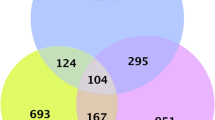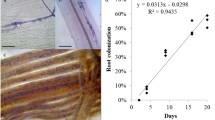Abstract
Transcriptional changes in Pisolithus tinctorius leading to ectomycorrhizal formation in P. tinctorius– Castanea sativa were investigated using a 12-h fungal interaction in vitro system. Using a 3107-cDNA clone microarray, 34 unique expressed sequence tags (ESTs) were found to be differentially expressed. These ESTs represent 14 known genes, 5 upregulated and 9 downregulated, and 20 orphan sequences. Some transcripts of upregulated genes (with unknown function) were previously identified in other mycorrhizal Pisolithus spp. associations. ESTs for S-adenosyl-l-homocysteine hydrolase and several orphan sequences were identified in our system. The identified transcript of downregulated genes involved hydrophobins, 5S, 18S, and 28S ribosomal RNA genes, large subunits of ribosomal RNA (mitochondrial gene), and two types of heat shock proteins. This study demonstrates the high complexity of molecular events involved in the preinfection steps and suggests the utilization of different fungal gene repertories before ectomycorrhizal formation. These data constitute a first contribution for the molecular understanding of early signaling events between P. tinctorius and C. sativa roots during ectomycorrhizal formation.
Similar content being viewed by others
References
Ausubel FM, Brent R, Kingston RE et al (eds) (1993) Current protocols in molecular biology, 4th edn. Wiley, New York
Baptista P, Martins A, Pais MS, Tavares RM, Lino-Neto T (2007) Involvement of reactive oxygen species during early stages of ectomycorrhiza establishment between Castanea sativa and Pisolithus tinctorius. Mycorrhiza 17:185–193
Breitling R, Armengaud P, Amtmann A, Herzyk P (2004) Rank products: a simply, yet powerful, new method to detect differentially regulated genes in replicated microarray experiment. Fed Eur Biochem Soc Lett 573:83–92
Duplessis S, Courty P, Tagu D, Martim F (2005) Transcript patterns associated with ectomycorrhiza development in Eucalyptus globulus and Pisolithus microcarpus. New Phytol 165:599–611
Gupta RS (1995) Phylogenetic analysis of 90kD heat shock family of protein sequences and an examination of the relationship among animals, plants and fungi species. Mol Biol Evol 12(6):1063–1073
Harley J, Smith SE (1983) Mycorrhizal symbiosis. Academic Press, London
Hegde P, Qi R, Albernathy K et al (2000) A concise guide to cDNA microarray analysis. Biotechniques 29:548–562
Hilbert JL, Costa G, Martin F (1991) Ectomycorrhizin synthesis and polypeptide changes during the early stage of eucalypt mycorrhiza development. Plant Physiol 97:977–984
Johansson T, Le Quéré A, Ahren D et al (2004) Transcriptional responses of Paxillus involutus and Betula pendula during formation of ectomycorrhizal root tissue. Mol Plant–Microbe Interact 17(2):202–205
Kawalleck P, Plesh G, Hahlbrock K, Somssich IE (1992) Induction by fungal elicitor of S-adenosyl-l-methionine synthetase and S-adenosyl-l-homocysteine hydrolase mRNAs in cultured cell and leaves of Petroselinum crispum. Proc Natl Acad Sci USA 89:4713–4717
Laurent P, Voiblet C, Tagu D et al (1999) A novel class of ectomycorrhiza-regulated cell wall polypeptides in Pisolithus tictorius. Mol Plant–Microbe Interact 12(10):862–871
Le Quéré A, Wright DP, Söderström B, Tunlid A, Johansson T (2005) Global patterns of gene regulation associated with the development of ectomycorrhiza between Birch (Betula pendula Roth.) and Paxillus involutus. Mol Plant–Microbe Interact 18(7):659–673
Martin F, Duplessis S, Ditengou F, Lagrange H, Voiblet C, Frédéric L (2001) Developmental cross talking in the ectomycorrhizal symbiosis: signal and communication genes. New Phytol 151:145–154
Martins A, Barroso J, Pais MS (1996) Effect of ectomycorrhizal fungi on survival and growth of micropropagated plants and seedlings of Castanea sativa Mill. Mycorrhiza 6:265–270
Marx DH (1969) The influence of ectotrophic mycorrhizal fungi on the resistance of pine roots to pathogenic infections. I. Antagonism of mycorrhizal fungi to root pathogenic fungi and soil bacteria. Phytopathology 59:153–163
Menotta M, Amicucci A, Sisti D, Gioacchini AM, Stocchi V (2004) Differential gene expression during pre-symbiotic interaction between Tuber borchii Vittad. and Tilia Americana L. Curr Genet 46:158–165
Nehls U, Mikolajewski S, Ecke M, Hampp R (1999) Identification and expression analysis of two fungal cDNA regulated by ectomycorrhiza and fruit body formation. New Phytol 144:195–202
Polidori E, Agostini D, Zeppa S et al (2002) Identification of differentially expressed cDNA clones in Tilia platiphyllos–Tuber borchii ectomycorrhizae using a differential screening approach. Mol Genet Genomics 266:858–864
Rerie WG, Whitecross MP, Higgins TJ (1991) Developmental and environmental regulation of pea legumin genes in transgenic tobacco. Mol Gen Genet 225:148–157
Stecher H, Felfer U, Faber K (1997) Large-scale production of Mandelate racemase by Pseudomonas putida ATCC 12633: optimization of enzyme induction and development of a stable crude enzyme preparation. J Biotechnol 56:33–40
Tagu D, Nasse B, Martin F (1996) Cloning and characterization of hydrophobins-encoding cDNAs from the ectomycorrhizal Basidiomycete Pisolithus tinctorius. Gene 168:93–97
Tagu D, De Bellis R, Balestrini R et al (2001) Immunolocalization of hydrophobin HYDPt-1 from the ectomycorrhizal basidiomycete Pisolithus tinctorius during colonization of Eucalyptus globulus roots. New Phytol 149:127–135
Tagu D, Lapeyrie F, Martin F (2002) The ectomycorrhizal symbiosis: genetics and development. Plant Soil 244:97–105
Voiblet C, Duplessis S, Encelot L, Martin F (2001) Identification of symbiosis-regulated genes in Eucalyptus globulus–Pisolitus tinctorius ectomycorrhiza by differential hybridization of arrayed cDNAs. Plant J 25(2):181–191
Zaretsky M, Sitrit Y, Mills D, Roth-Bejerano N, Kagan-Zur V (2006) Expression of fungal genes at preinfection and mycorrhiza establishment between Terfezia boudieri isolates and Cistus incanus hairy root clones. New Phytol 171:837–846
Acknowledgments
This work was partially supported by CAPES (Coordenação de Aperfeiçoamento de Pessoal de Nível Superior/Ministério da Educação–Brazil) through a Ph.D. scholarship and grant conceded to the first author. L. C. Maia acknowledges CNPq (Conselho Nacional de desenvolvimento Científico e Tecnológico, Brazil) support. Dra. Lisete Souza acknowledges FCT (Fundação para a Ciência e Tecnologia, Portugal) support (projects FCT/POCI 2010 and PTDC/MAT/64353/2006). The authors thank Dr. Gregory Mueller (Field Museum of Natural History, Chicago, USA) and Dr. Rita C. C. Maia (CPqAM/FIOCRUZ) for their help in the manuscript review.
Author information
Authors and Affiliations
Corresponding author
Rights and permissions
About this article
Cite this article
Acioli-Santos, B., Sebastiana, M., Pessoa, F. et al. Fungal Transcript Pattern During the Preinfection Stage (12 h) of Ectomycorrhiza Formed Between Pisolithus tinctorius and Castanea sativa Roots, Identified Using cDNA Microarrays. Curr Microbiol 57, 620–625 (2008). https://doi.org/10.1007/s00284-008-9253-2
Received:
Accepted:
Published:
Issue Date:
DOI: https://doi.org/10.1007/s00284-008-9253-2




